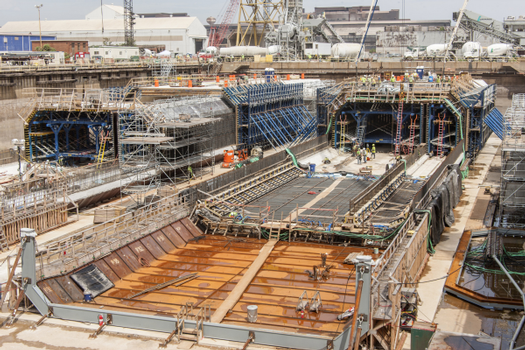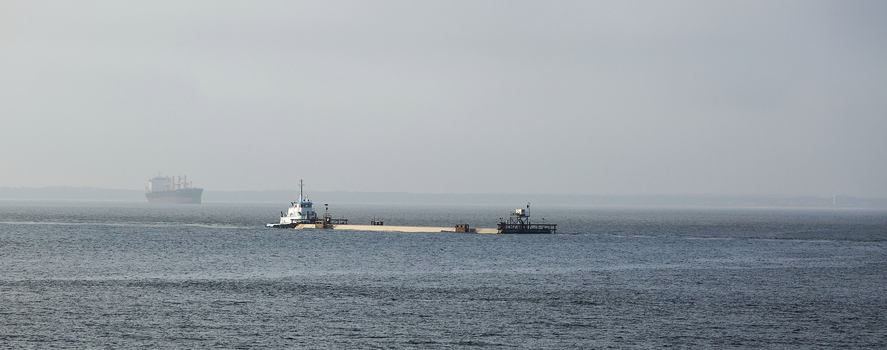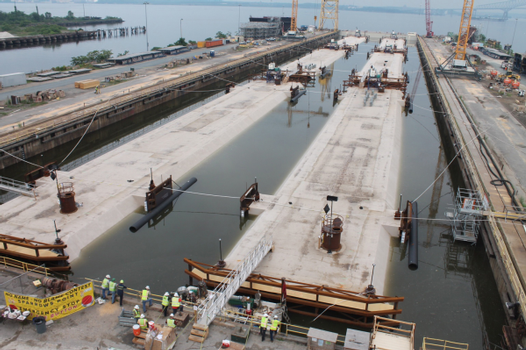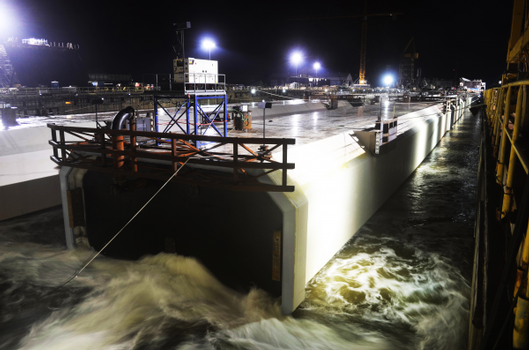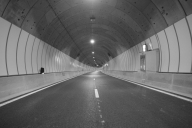High-Performing, Cost-Efficient Solutions for Underwater Tunnel Construction
To relieve the chronic congestion in and around the existing two-lane Midtown Tunnel in downtown Norfolk, Va., rehabilitation of the tunnel is planned along with building a new two-lane immersed tunnel alongside it. The Second Midtown Tunnel is being constructed featuring Doka's heavy-duty supporting system SL-1. Together with the existing tunnel, the Second Midtown Tunnel will double traffic capacity and improve travel times. The contractor chose Doka for their experience on a similar project in 2005 on the 1.9-mile-long Busan-Geoje Fixed Link - one of the deepest immersed tunnels in the world at 197 feet.
Media
A ‘deep-diving mission' to get the traffic flowing again
The 0.7-mile-long Second Midtown tunnel will consist of eleven separate segments, each measuring approximately 350' long by 54' wide by 29' high. Each segment weighs nearly 13 tons and will be pre-cast in a dry dock in Baltimore, Maryland. The finished segments will be transported by barge escort approximately 200 miles on the Chesapeake Bay to the immersion site in Norfolk. Here, the tunnel segments will be fixed together underwater and sealed with rubber seals. This special system and the use of watertight concrete make the Second Midtown Tunnel only the second such tunnel in the U.S. not requiring an external steel skin.
Preassembly work on the Doka tunnel formwork traveller was completed at the beginning of 2013, and the first trial pours were completed in June. The first production pour of Element 1 / Segment 1 (E1 / S1) took place on July 9. The 12-hour, 650 cubic yard pour went smoothly and problem free. After 3 days, the formwork was stripped and rolled ahead on the rail into position for the next pour. SKW was very pleased with the concrete appearance and overall performance of the Doka formwork.
Due to the high concrete temperatures that occur during the curing process, as well as the high ambient temperatures of the hot and humid summer months (96 degrees Fahrenheit), SKW decided to add liquid nitrogen to the concrete mix to lower the concrete temperature in an effort to delay the cure time to control the concrete shrinkage and minimize the possibility of cracking in the watertight ITT elements. In addition, SKW installed a system of heating and cooling system throughout the invert, walls, and roof of each segment. A glycol coolant solution is being pumped through the hoses during the curing process to help control the concrete temperatures.
From February 2013 until April 2014, preparations at the tunnel site under the Elizabeth River will be in full swing. The riverbed around the tunnel will be dredged into shape so that the segments can be lowered into place at a depth of almost 200 feet. The project is slated for completion in September 2016.
Flexible, high-performing formwork solution
Designed for high loads, the heavy-duty supporting system SL-1 provides a strong, torsion-proof frame for the tunnel formwork. This modularly designed system ensures swift, economical construction progress regardless of the shape and load. The extra-stable formwork allows only the smallest of deformations, and can easily be re-adjusted in any direction using fine pitch screw threads. The fully rentable tunnel formwork traveller achieves short set-up times with the preassembly of the formwork and the heavy-duty SL-1 components, as well as short repositioning times due to the all-hydraulic rail guidance. With the aid of winches and hand levers, the heavy equipment being used for the Second Midtown Tunnel can be repositioned by muscle power alone. The formwork traveller can be moved safely even on steep longitudinal and transverse gradients. The integrated working platforms and ladderways on this CE-labelled system provide extra safety during the forming operations.
Large surfaces, great result
The heavy-duty supporting system SL-1 is fully compatible with large-area formwork Top 50. This flexible system accommodates any architectural requirement and saves crane time because of its large gang-forms. The element joints are designed to ensure a perfect joint pattern. On the Second Midtown Tunnel, the high-load components allow the use of a hydrostatic design basis for the center wall of the tunnel segments. This makes rapid pouring possible, with no need to worry about the rate of placing.
Right from the beginning, the project requirements have called for precisely detailed preparations and strong teamwork from the international experts involved. To achieve the best possible exchange of expertise, a Doka USA engineering team member was sent to Doka's headquarters during the planning phase to work with the specialists from the Tunnel Competence Centre on identifying the right solution. As such, this collaboration helped choose a suitable solution to give the client comprehensive service.
According to Andreas Zitzenbacher from the Business Development Competence Centre, the goals of this international project-management assignment were to achieve high precision. "The challenge facing us on the Second Midtown Tunnel is to achieve tight tolerances and ultra-high precision. This means that we have to communicate and work together very intensively," said Zitzenbacher. Regular face-to-face meetings as well as telephone and video conferences are held to ensure that the project is carried out in the most effective way.
Proven Formwork Solution
The heavy-duty supporting system SL-1 has already performed convincingly under difficult geological conditions on Switzerland's 35-mile-long Gotthard Base Tunnel - the longest railway tunnel in the world. Its short cycle times, and ease of formwork set-up and removal, were clinch factors for the client. This heavy-duty supporting system was also fielded on the large-scale upgrade and extension of the M4 metro line in the Hungarian capital Budapest.
Facts:
Location: Norfolk, Virginia
Products: Products: Heavy-duty supporting system SL-1, Large-area formwork Top 50, and a custom steel construction for the outside formwork
Contractors: SKW consortium of Skanska, Kiewit & Weeks Marine
Overall project cost: $2.4 billion USD
Start date and scheduled end of date: 2012 – September 2016
References
Structure Types
- About this
data sheet - Product-ID
7238 - Published on:
03/03/2015 - Last updated on:
26/11/2015

